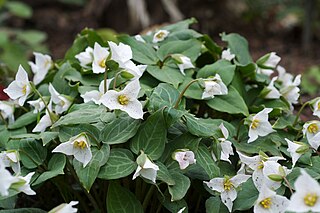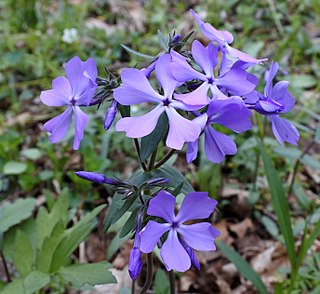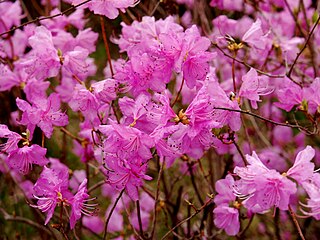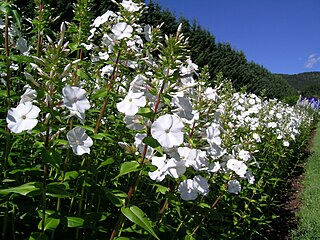
Fritillaria meleagris is a Eurasian species of flowering plant in the lily family Liliaceae. Its common names include snake's head fritillary, snake's head, chess flower, frog-cup, guinea-hen flower, guinea flower, leper lily, Lazarus bell, chequered lily, chequered daffodil, drooping tulip or, in the British Isles, simply fritillary. The plant is a bulbous perennial native to the flood river plains of Europe where it grows in abundance.

Silene chalcedonica, the Maltese-cross or scarlet lychnis, is a species of flowering plant in the family Caryophyllaceae, native to central and eastern Russia, Kazakhstan, Mongolia and northwestern China. Other common names include flower of Bristol, Jerusalem cross and nonesuch.

Gymnocarpium dryopteris, the western oakfern, common oak fern, oak fern, or northern oak fern, is a deciduous fern of the family Cystopteridaceae. It is widespread across much of North America and Eurasia. It has been found in Canada, the United States, Greenland, China, Japan, Korea, Russia, and most of Europe.

Dasylirion wheeleri is a species of flowering plant in the asparagus family (Asparagaceae), native to arid environments of northern Mexico and the southwestern United States.

Viburnum tinus, the laurustinus, laurustine or laurestine, is a species of flowering plant in the family Adoxaceae, native to the Mediterranean area of Europe and North Africa. Laurus signifies the leaves' similarities to bay laurel.

Pseudotrillium is a monotypic genus of flowering plant in the family Melanthiaceae. Its sole species, Pseudotrillium rivale, is commonly known as the brook wakerobin. It is endemic to the Siskiyou Mountains of southern Oregon and northern California. The Latin specific epithet rivale means “growing by streams”, with reference to a preferred habitat.

Jasminum nudiflorum, the winter jasmine, is a slender, deciduous shrub native to China. The flower's blossoming peaks right after winter, which is why it is also named Yingchun (迎春) in Chinese, which means "the flower that welcomes Spring". It is widely cultivated as an ornamental and is reportedly naturalized in France and in scattered locations in the United States.

Polystichum aculeatum, the hard shield-fern, is an evergreen fern native to Europe. It is most abundant in upland regions of the British Isles and western France, where it benefits from the combination of mild winters and moist summers, but also occurs more locally across most of Europe except northern Scandinavia, northern Russia; in the Mediterranean region it is confined to high altitudes. It grows on steep slopes in woodlands. it is sometimes considered an indicator of the presence of ancient woodlands.

Euonymus alatus, known variously as winged spindle, winged euonymus, or burning bush, is a species of flowering plant in the family Celastraceae, native to central and northern China, Japan, and Korea.

Rhododendron luteum, the yellow azalea or honeysuckle azalea, is a species of flowering plant in the heath family Ericaceae, native to southeastern Europe and southwest Asia. In Europe, it occurs from southern Poland and Austria, south through the Balkans, and east to southern Russia; and in Asia, east to the Caucasus.

Vinca major, with the common names bigleaf periwinkle, large periwinkle, greater periwinkle and blue periwinkle, is a species of flowering plant in the family Apocynaceae, native to the western Mediterranean. Growing to 25 cm (10 in) tall and spreading indefinitely, it is an evergreen perennial, frequently used in cultivation as groundcover.

Phlox subulata the creeping phlox, moss phlox, moss pink or mountain phlox, is a species of flowering plant in the family Polemoniaceae, native to eastern and central USA, and widely cultivated.

Phlox divaricata, the wild blue phlox, woodland phlox, or wild sweet william, is a species of flowering plant in the family Polemoniaceae, native to forests and fields in eastern North America.

Senna artemisioides, commonly known as wormwood senna, silver senna or silver cassia, is a species of flowering plant in the family Fabaceae and is endemic to Australia, where it is found in all mainland states and territories. It is a small, woody shrub with silver-green leaves and yellow flowers.

Phlox paniculata is a species of flowering plant in the phlox family (Polemoniaceae). It is native to parts of the eastern and central United States. It is extensively cultivated in temperate regions as an ornamental plant and has become established in the wild in scattered locales in other regions. Common names include fall phlox, garden phlox, perennial phlox, summer phlox, and panicled phlox.

Phlomis fruticosa, the Jerusalem sage, is a species of flowering plant in the family Lamiaceae, native to Albania, Cyprus, Greece, Italy, Turkey, and countries of the former Yugoslavia.

Heliopsis helianthoides is a species of flowering plant in the family Asteraceae, known by the common names rough oxeye, smooth oxeye and false sunflower. It is native to eastern and central North America from Saskatchewan east to Newfoundland and south as far as Texas, New Mexico, and Georgia.

Viscaria vulgaris, the sticky catchfly or clammy campion, is a flowering plant in the family Caryophyllaceae.

Rhododendron mucronulatum, the Korean rhododendron or Korean rosebay, is a rhododendron species native to Korea, Mongolia, Russia, and parts of northern China. It is a deciduous shrub that grows to 1–2 m (3.3–6.6 ft) in height, with elliptic or elliptic-lanceolate leaves, 3–7 cm long by 1–3.5 cm wide. The reddish-purple flowers appear in late winter or early spring, often on the bare branches before the foliage unfurls. It inhabits forested regions at 1,600–2,300 m (5,200–7,500 ft).

Phlox carolina, the thickleaf phlox, is a species of flowering plant in the family Polemoniaceae. It is an herbaceous perennial growing to 1.2 m (4 ft) tall by 45 cm (18 in) wide, with leaves to 13 cm (5 in) long, and purple or pink flowers in summer. The specific epithet carolina refers to its native habitat in the eastern United States. It grows in woodland edges and openings. Flowers attract bees, hummingbirds, and butterflies.





















